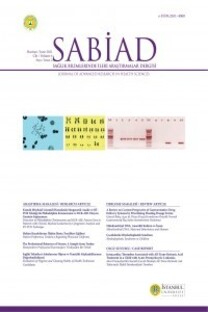LİZENSEFALİ SPEKTRUMU OLGULARINDA GENOTİP-FENOTİP İLİŞKİSİ
Lizensefali, nöronal migrasyon anomalisi, Miller-Dieker sendromu, lissencephaly, neuronal migration anomalies, Miller-Dieker syndrome
GENOTYPE-PHENOTYPE CORRELATION IN CASES WITH LISSENCEPHALY SPECTRUM
___
- 1. Dobyns WB, Guerrini R, Leventer RL. Malformations of cortical development. İn: Swaiman KF, Ashwal S, Ferriero DM, Schor NF, editors. Swaiman’s Pediatric Neurology: Principles and Practice. ed 5. Edinburgh: Elsevier Saunders; 2012. p. 202-31. google scholar
- 2. Di Donato N, Timms AE, Aldinger KA, Mirzaa GM, Bennett JT, Collins S, et al. Analysis of 17 genes detects mutations in 81% of 811 patients with lissencephaly. Genet Med 2018;20(11):1354-64. google scholar
- 3. Di Donato N, Chiari S, Mirzaa GM, Aldinger K, Parrini E, Olds C, et al. Lissencephaly: Expanded imaging and clinical classification. Am J Med Genet A 2017;173(6):1473-88. google scholar
- 4. Kars ME, Basak AN, Onat OE, Bilguvar K, Choi J, İtan Y, et al. The genetic structure of the Turkish population reveals high levels of variation and admixture. PNAS 2021;118 (36):e2026076118. doi. org/10.1073/pnas.202607611 google scholar
- 5. Dobyns WB, Elias ER, Newlin AC, Pagon RA, Ledbetter DH. Causal heterogeneity in isolated lissencephaly. Neurology 1992;42(7):1375-88. google scholar
- 6. Dobyns WB, Truwit CL, Ross ME, Matsumoto N, Pilz DT, Ledbetter DH, et al. Differences in the gyral pattern distinguish chromosome 17-linked and X-linked lissencephaly. Neurology 1999;53(2):270-7. google scholar
- 7. Kato M, Dobyns WB. Lissencephaly and the molecular basis of neuronal migration. Hum Mol Genet 2003;12 Spec No 1:R89-96. google scholar
- 8. Feng Y, Olson EC, Stukenberg PT, Flanagan LA, Kirschner MW, Walsh CA. LİS1 regulates CNS lamination by interacting with mNudE, a central component of the centrosome. Neuron 2000;28(3):665-79. google scholar
- 9. Reiner O, Carrozzo R, Shen Y, Wehnert M, Faustinella F, Dobyns WB, et al. İsolation of a Miller-Dieker lissencephaly gene containing G protein beta-subunit-like repeats. Nature 1993;364(6439):717-21. google scholar
- 10. Sicca F, Kelemen A, Genton P, et al. Mosaic mutations of the LİS1 gene cause subcortical band heterotopia. Neurology 2003;61(8):1042-6. google scholar
- 11. Saillour Y, Carion N, Quelin C, Leger PL, Boddaert N, Elie C, et al. LİS1-related isolated lissencephaly: spectrum of mutations and relationships with malformation severity. Arch Neurol 2009;66(8):1007-15. google scholar
- 12. Cardoso C, Leventer RJ, Matsumoto N, Kuc JA, Ramocki MB, Mewborn SK, et al. The location and type of mutation predict malformation severity in isolated lissencephaly caused by abnormalities within the LİS1 gene. Hum Mol Genet 2000;9(20):3019-28. google scholar
- 13. Mohan R, John A. Microtubule-associated proteins as direct crosslinkers of actin filaments and microtubules. İUBMB Life 2015;67(6):395-403. google scholar
- 14. des Portes V, Francis F, Pinard JM, Desguerre İ, Moutard ML, Snoeck İ, et al. Doublecortin is the major gene causing X-linked subcortical laminar heterotopia (SCLH). Hum Mol Genet 1998;7(7):1063-70. google scholar
- 15. Gleeson JG, Allen KM, Fox JW, Lamperti ED, Berkovic S, Scheffer İ, et al. Doublecortin, a brain-specific gene mutated in human X-linked lissencephaly and double cortex syndrome, encodes a putative signaling protein. Cell 1998;92(1):63-72. google scholar
- 16. Poretti A, Boltshauser E, Doherty D. Cerebellar hypoplasia: differential diagnosis and diagnostic approach. Am J Med Genet C Semin Med Genet 2014;166C(2):211-6. google scholar
- 17. Boycott KM, Bonnemann C, Herz J, Neuert S, Beaulieu C, Scott JN, et al. Mutations in VLDLR as a cause for autosomal recessive cerebellar ataxia with mental retardation (dysequilibrium syndrome). J Child Neurol 2009;24(10):1310-5. google scholar
- Yayın Aralığı: Yılda 3 Sayı
- Başlangıç: 2018
- Yayıncı: İstanbul Üniversitesi
Emel USTA, Sibel KÖKTÜRK, Sibel DOĞAN, Ayşe ALTUN, Sibel BULGURCUOGLU KURAN, Feride ÖZDEMİR
PORSELEN LAMİNAT KAPLAMA HAKKINDA BİLGİ KAYNAĞI OLARAK YOUTUBE
Pınar NAİBOĞLU, Sevde GÖKSEL, Gül AYKANAT
TÜRKİYE POPÜLASYONUNDA HLA-DQ POLİMORFİZMLERİNİN HEPATİT B VİRÜS ENFEKSİYONU İLE İLİŞKİSİ
Bülent ÇAKAL, Muzaffer ARIKAN, Alp ATASOY, Bilger ÇAVUŞ, Mehveş PODA, Mesut BULAKÇI, Mine GÜLLÜOĞLU, Mehmet DEMİRCİ, Filiz AKYÜZ
COVİD-19 HASTALARININ RİSK SINIFLAMASINDA ENFLAMATUVAR İNDEKSLERİN PROGNOSTİK ROLÜ
Maide Hacer ALAGÖZ, Ayşe Enise GÖKER, Evin ADEMOĞLU
KÖK HÜCRE BAĞIŞÇILIĞI FARKINDALIĞININ DEĞERLENDİRİLMESİ
Çiğdem KEKİK ÇINAR, Ayşe Emel ÖNAL, Yasemin OYACI, Hülya GÜL, Nilgün BOZBUĞA, Fatma Savran OĞUZ
LİZENSEFALİ SPEKTRUMU OLGULARINDA GENOTİP-FENOTİP İLİŞKİSİ
Ayça Dilruba ASLANGER, Oya UYGUNER, Birsen KARAMAN, Seher BAŞARAN, Hülya KAYSERİLİ
GENİŞ KAPASİTELİ BİR NÜKLEER TIP MERKEZİNDE KATI RADYOAKTİF ATIK YÖNETİMİ
Mustafa DEMİR, PH.D., Nazenin İPEK IŞIKÇI, Nami YEYİN
Fatma Savran OĞUZ, Çiğdem KEKİK, Rustu OGUZ, Demet KIVANÇ, Deniz SARGIN, Sevgi KALAYOĞLU-BEŞIŞIK
Serdar NEPESOV, Sinem FIRTINA, Deniz AYGÜN, Begüm IŞIKGİL, Yıldız CAMCIOĞLU, Ayça KIYKIM, Esra ÖZEK, Yasemin KENDİR DEMİRKOL, Akif AYAZ
